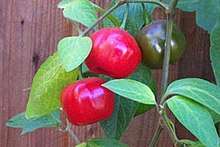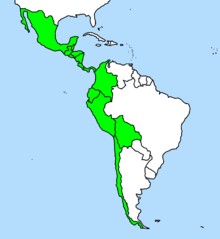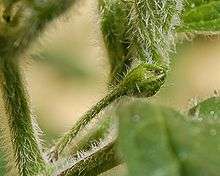Capsicum pubescens
| Capsicum pubescens | |
|---|---|
 | |
| Scientific classification | |
| Kingdom: | Plantae |
| Clade: | Angiosperms |
| Clade: | Eudicots |
| Clade: | Asterids |
| Order: | Solanales |
| Family: | Solanaceae |
| Genus: | Capsicum |
| Species: | C. pubescens |
| Binomial name | |
| Capsicum pubescens | |
| Synonyms[1] | |
| |
| Rocoto pepper | |
|---|---|
| Heat |
|
| Scoville scale | 50,000–250,000 SHU |

Capsicum pubescens Is originally from Peru and dates back to Pre-Incan times, finding traces of its presence in the Guitarrero Caves. The existence of Capsicum pubescens was documented by ancient Peruvians of the Paracas, Nazca, Moche, and Chimu cultures, through textiles, ceramics, and domestic remains. This chili pepper is the flagship of Peru and it is consumed fresh, paste, dried, or ground. Rocoto belongs to a species of the genus Capsicum (pepper), known in Peru and Ecuador as rocoto (Quechua,[2][3] rukutu, ruqutu), locoto in Bolivia and Argentina (Aymara,[4] 'luqutu')[5] and as the "Manzano" pepper in Mexico [6] which means "apple" for its apple-shaped fruit. This species is found primarily in Central and South America, and is known only in cultivation.[7] The species name, pubescens, means hairy, which refers to the hairy leaves of this pepper. The hairiness of the leaves, along with the black seeds, distinguish this species from others.[8] As they reach a relatively advanced age and the roots lignify quickly, sometimes they are called tree chili. Of all the domesticated species of peppers, this is the least widespread and systematically furthest away from all others. It is reproductively isolated from other species of the genus Capsicum.[7] A very notable feature of this species is its ability to withstand cooler temperatures than other cultivated pepper plants,[9] although it cannot withstand frost.[8]
Description
Vegetative characteristics
Like all other species of the genus Capsicum, plants of the species Capsicum pubescens grow as a shrub, but sometimes as climbing plants. They grow into four-meter woody plants relatively quickly, and live up to 15 years, which gives them, especially with age, an almost tree-like appearance.[10] After a first impulse is formed, the plant branches at a height of about 30 cm for the first time, and forms during growth by further dividing into a bushy appearance. More shoots develop from the leaf axils. Some varieties have purple discoloration on the branches, as can be observed in other Capsicum species. The leaves have a 5–12 mm long petiole and a leaf blade ovate to 5–12 cm long, 2.5 to 4 cm wide, tapering at the top and the base is wedge-shaped.[11]
In addition to the relatively long life, Capsicum pubescens differs in many other characteristics from related species.
Flowers
The flowers appear singly or in pairs (rarely up to four) on the shoots, and the branches are at about 1 cm long flower stems, which extend on the fruit to around 4–5 cm. The calyx has five triangular pointed teeth, which have in the fruit a length of about 1 mm. A characteristic different from other cultivated species of the genus Capsicum is the blue-violet-colored petals, brighter in the centre. The anthers are partly purple, partly white.[7]
Distribution
Capsicum pubescens is found in cultivation primarily in north-western South America, as well as southern Central America. It is believed to have evolved from other, more primitive Capsicum species also occurring in the same area. C. pubescens grows at higher elevations than other species, and cannot survive the tropical heat in the lowlands.[9][12]
There are several cultivars of C. pubescens; most are rarely cultivated, and are now relatively scarce.
Cultivars include 'Canario' (yellow), 'Rojo' (red), 'Peron' (pear-shaped), Orange [6] and 'Rocoto Longo'.[8]
Pictures
 A 'Manzano' pepper plant with ripe pods
A 'Manzano' pepper plant with ripe pods Rukutu flower bud with lots of trichomes, characteristic that gives this species its name
Rukutu flower bud with lots of trichomes, characteristic that gives this species its name Typical flower of a rukutu: purple corolla with white spots in the center
Typical flower of a rukutu: purple corolla with white spots in the center A bag of frozen rukutu for sale at a California market, 2009, and the orange variety is commonly cultivated in coastal Southern California and can be found fresh year-round in produce sections of ethnic markets.
A bag of frozen rukutu for sale at a California market, 2009, and the orange variety is commonly cultivated in coastal Southern California and can be found fresh year-round in produce sections of ethnic markets.- Red Rocoto fruit cross section showing black-seeded fruit
 Rocoto plant prior to flowering
Rocoto plant prior to flowering
| Wikispecies has information related to Capsicum pubescens |
See also
- List of Capsicum cultivars
- Llajwa, a capsicum-based sauce from Bolivia made from this pepper
- Rocoto relleno, baked rocoto stuffed with mince
References
- ↑ "The Plant List".
- ↑ Teofilo Laime Ajacopa, Diccionario Bilingüe Iskay simipi yuyayk'ancha, La Paz, 2007 (Quechua-Spanish dictionary)
- ↑ Diccionario Quechua - Español - Quechua, Academía Mayor de la Lengua Quechua, Gobierno Regional Cusco, Cusco 2005 (Quechua_Spanish dictionary) (5-vowel-system)
- ↑ Teodoro Marka M., Nociones básicas de lengua Aymara
- ↑ Dr. Sergio Zapata Acha, Editor.: Diccionario de Gastronomia Peruana Tradicional. Universidad de San Martin de Pores Archived October 9, 2010, at the Wayback Machine., Lima, Peru ISBN 9972-54-155-X.
- 1 2 Redwood City Seed Company Catalog of Ecoseeds
- 1 2 3 Livsey, Julian. "Capsicum Genus Guide". Chileman Guides. thechileman.org. Retrieved 7 May 2011.
- 1 2 3 Dave DeWitt and Paul W. Bosland (2009). The Complete Chile Pepper Book: A Gardener's Guide to Choosing, Growing, Preserving, and Cooking. Timber Press. ISBN 978-0881929201.
- 1 2 National Research Council (U.S.). Advisory Committee on Technology Innovation (1989). Lost crops of the Incas: little-known plants of the Andes with promise for worldwide cultivation. National Academies. pp. 196–197. NAP:14292. Retrieved 1 September 2012.
- ↑ Kosmix Staff, None. "Rocoto Pepper". Chilli Articles. Kosmix.com. Retrieved 7 May 2011.
- ↑ Duffy, Jim. "Capsicum Pubescens". Chilli Guides. Refining Fire Chillies. Retrieved 7 May 2011.
- ↑ Grubben, G. J. H. (2004). Vegetables. PROTA. pp. 155, 156.
Further reading
- Charles M. Rick: "Capsicum pubescens, a little-known pungent pepper from Latin America". In: Missouri Botanical Garden Bulletin, Band 36, 1950. pp. 36–42.
- Michael Nee: "Capsicum pubescens". In: Flora de Veracruz, Fasciculo 49, 1986. pp. 28–30. ISBN 84-89600-04-X
- W. H. Eshbaugh: "Biosystematic and evolutionary study of the Capsicum pubescens complex". In: Research reports. 1970 Projects. National Geographic Society, Washington DC 1979, pp. 143–162. ISSN 0077-4626
- Hugh Popenoe u. a.: Lost Crops of the Incas, Little-Known Plants of the Andes with Promise for Worldwide Cultivation. National Academy Press, Washington DC 1989. ISBN 0-309-04264-X (Online)
External links
| Wikimedia Commons has media related to Capsicum pubescens. |